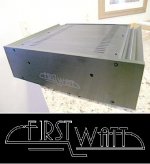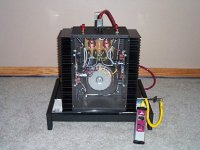roddyama said:Duck,
You do know that these won't be the first reasonably priced Pass designed amps made available to the retail market, don't you? They will be just the first of the Zen/Aleph topology that have been made available.
The Volksamps were quite reasonable priced (though I never seen one over here) and the original Alelph3 an 5 probably were in the upper mid price range.
However the current Pass models over here vary in price from a nice little Toyota to a fat V8 BMW. Only a few people can or are willing to spend so much money on audio. So its good that this type of audio becomes a little more affordable (again). To oppose home cinima systems and mp3 a bit.
No, I was thinking of the Forte and Adcom amps.Duck-Twacy said:
The Volksamps were quite reasonable priced (though I never seen one over here) and the original Alelph3 an 5 probably were in the upper mid price range.
Jam,jam said:Selling stuff on the street corner .............Mr.Pass?


Regards,
Jam
Checkout the location of the seller in this eBay Ad.
roddyama said:Checkout the location of the seller in this eBay Ad.
RenoMark is our authorized dealer in Nevada, and a fine
one he is.
When I was thinking of the cheapest amp I ever offered, I
was referring to the CAS-1.
I almost bought a CAS-1 in the early 80's but was lured away by a real good price on a Bryston 3b.Nelson Pass said:
RenoMark is our authorized dealer in Nevada, and a fine
one he is.
When I was thinking of the cheapest amp I ever offered, I
was referring to the CAS-1.
 Sorry Nelson.
Sorry Nelson.
Here's a CAS-1 for sale ... http://cgi.ebay.com/ws/eBayISAPI.dll?ViewItem&item=3073168376&category=39783
Well...
This is one of those semi-urban legend gripes that no doubt appeared in the description paragraph of some audio rag eons ago.
The problem you mention is relative to the size of the heatsink. Sure the heatsink pictured might be 15% more efficient if mounted vetically, but so what? As long as its spec'ed for the right temperature rise above ambient.
I'd guess it has something to do with this construction technique resulting in a lower cost for the consumer, since it is generally cheaper to extrude a narrow heatsink than a wide one. Of course you could use two narrow heatsinks mounted vertically, but you've added extra cutting operations and parts handling.
This is one of those semi-urban legend gripes that no doubt appeared in the description paragraph of some audio rag eons ago.
The problem you mention is relative to the size of the heatsink. Sure the heatsink pictured might be 15% more efficient if mounted vetically, but so what? As long as its spec'ed for the right temperature rise above ambient.
I'd guess it has something to do with this construction technique resulting in a lower cost for the consumer, since it is generally cheaper to extrude a narrow heatsink than a wide one. Of course you could use two narrow heatsinks mounted vertically, but you've added extra cutting operations and parts handling.
Being in finance 15% of anything is a big number to trim off.
It is better to run cooler than just meeting the specs. No sense in shorting the life of parts. It's not a big deal to put the better type of heat sinking on there.
The amp is hardly stylish. It's pretty plan looking. I do not care much about style if the money can be put towards better performance.
Those heat sinks are also a nice dust collector.
It is better to run cooler than just meeting the specs. No sense in shorting the life of parts. It's not a big deal to put the better type of heat sinking on there.
The amp is hardly stylish. It's pretty plan looking. I do not care much about style if the money can be put towards better performance.
Those heat sinks are also a nice dust collector.
Of course, this isn't finance. Isn't that like applying the rules of poker to a game of chess?
Do you like the show "Mythbusters" ?
Not being in finance, I conducted a simple experiment:
I placed my Penultimate Zen amp in the normal position (heatsink fins perpendicular to the floor). I then allowed the amp to heat up from a cold start, taking heatsink temperature measurements at 30 minute intervals. The temperature stabilized after about 2 hours at 54.6 C, or about 30.4 degrees C above the ambient temperature of my room.
I turned the amp off and allowed it to completely cool.
I then placed the amp on its end (heatsink fins parallel with the floor) and took the same measuremnts. Once again, the temeprature had stabilized after 2 hours at 33.6 C above ambient.
A difference of 3.2 degrees, which will no doubt degrade the useful life of my amplifier by about one half of one percent. Of course, if this troubled me (which it doesn't) I could add about 10% to the length of the heatsink and the amp would once again idle at 30 degrees above ambient.
Being in finance you should understand that shaving $100 out of the cost of a unit goes a long way towards being able to sell the amp at a price fiscally challenged guys (not in finance) like me can afford.
I'm sure First Watt has designed the amps to idle somewhere between 50 and 60 degrees C. Perhaps there is an asthetic argument here, but there certainly isn't a scientific one.
Mr. Pass. I'll take one of each. Thanks.
Do you like the show "Mythbusters" ?
Not being in finance, I conducted a simple experiment:
I placed my Penultimate Zen amp in the normal position (heatsink fins perpendicular to the floor). I then allowed the amp to heat up from a cold start, taking heatsink temperature measurements at 30 minute intervals. The temperature stabilized after about 2 hours at 54.6 C, or about 30.4 degrees C above the ambient temperature of my room.
I turned the amp off and allowed it to completely cool.
I then placed the amp on its end (heatsink fins parallel with the floor) and took the same measuremnts. Once again, the temeprature had stabilized after 2 hours at 33.6 C above ambient.
A difference of 3.2 degrees, which will no doubt degrade the useful life of my amplifier by about one half of one percent. Of course, if this troubled me (which it doesn't) I could add about 10% to the length of the heatsink and the amp would once again idle at 30 degrees above ambient.
Being in finance you should understand that shaving $100 out of the cost of a unit goes a long way towards being able to sell the amp at a price fiscally challenged guys (not in finance) like me can afford.
I'm sure First Watt has designed the amps to idle somewhere between 50 and 60 degrees C. Perhaps there is an asthetic argument here, but there certainly isn't a scientific one.
Mr. Pass. I'll take one of each. Thanks.
Attachments
I wonder why the front panel is not a first watt style.
It looks unnecessarily thick. Does it work as a part of heat sink (longer time to reach to the max. temp.)? Or, does work to attract potential buyers who might evaluate the style more than the real meaning of the first watt?
It looks unnecessarily thick. Does it work as a part of heat sink (longer time to reach to the max. temp.)? Or, does work to attract potential buyers who might evaluate the style more than the real meaning of the first watt?
Re: heatsinks, etc. Never overlook the obvious. I suspect Nelson is using back-stock Volksamp metal.
The question isn't whether the heatsink is mounted 'correctly' or not. The question is simply how much heat is the heatsink being asked to dissipate vs. how much it can dissipate in that configuration. Given that the FirstWatt website says that the amps are 10 and 15W, I don't think you're going to be looking at huge Pd problems...
Grey
The question isn't whether the heatsink is mounted 'correctly' or not. The question is simply how much heat is the heatsink being asked to dissipate vs. how much it can dissipate in that configuration. Given that the FirstWatt website says that the amps are 10 and 15W, I don't think you're going to be looking at huge Pd problems...
Grey
- Status
- This old topic is closed. If you want to reopen this topic, contact a moderator using the "Report Post" button.
- Home
- Amplifiers
- Pass Labs
- FirstWatt.com


